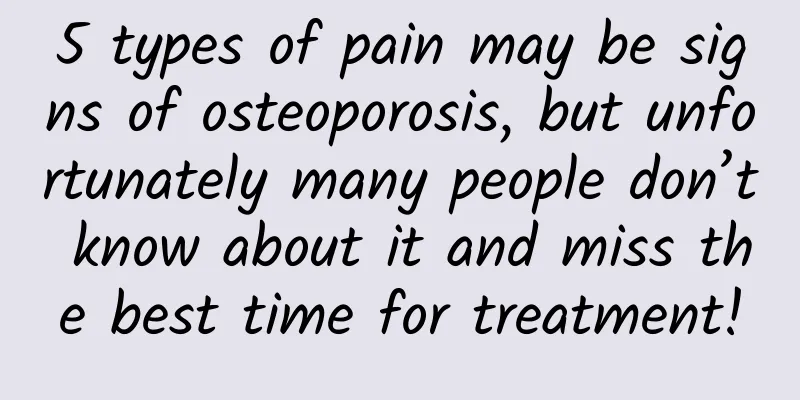5 types of pain may be signs of osteoporosis, but unfortunately many people don’t know about it and miss the best time for treatment!

|
As the global population ages, osteoporosis has become an important health issue that affects the quality of life of the elderly. When it comes to osteoporosis, most people think of fractures, hunchbacks, etc., but few people think that this disease can also cause various pains. In the first half of this year, the Geriatric Pain Disease Branch of the Chinese Geriatric Healthcare Medical Research Association specially organized experts in related fields to formulate the "Chinese Expert Consensus on Diagnosis, Treatment and Management of Osteoporotic Pain in the Elderly (2024 Edition)" based on China's national conditions to standardize and promote the clinical work of osteoporotic pain diagnosis and treatment in elderly patients in my country. So, today we will talk about osteoporotic pain. Copyright images in the gallery. Reprinting and using them may lead to copyright disputes. 5 types of pain that could be a sign of osteoporosis The causes of osteoporosis are complex, including genetic factors, immune factors, decreased sex hormones and calcitonin, increased corticosteroids, etc. Many patients usually experience various pains all over the body before their height becomes significantly shorter. The following 5 types of pain are usually signs of osteoporosis. 1 Night pain Osteoporosis patients often feel pain at night or in the early morning. This pain may be difficult to pinpoint and manifests as systemic discomfort. This pain may be related to micro-injuries accumulated during daytime activities, and the pain is more obvious when resting at night. 2 Low back pain Osteoporosis patients have obvious bone structure changes. The lower back, shoulders and neck are the parts that bear more weight and move more frequently, so these areas are where patients often feel pain. Lower back pain is aggravated during activities, especially after standing, sitting or doing certain physical activities for a long time. 3 Limb pain Osteoporosis may also cause pain in the extremities, especially when bearing weight or moving. This pain may be related to muscle fatigue, joint inflammation, or a pinched nerve. If pain occurs in the limbs without obvious trauma, especially at night or in the morning, this may be a sign of osteoporosis. The reason may be that when osteoporosis patients suffer vertebral fractures, the vertebral body is compressed and the intervertebral foramen becomes smaller, which may lead to compression of the spinal nerve roots, radiating pain in the limbs with or without sensory or motor disorders in the lower limbs, unilateral or bilateral intercostal neuralgia, pain behind the sternum (similar to angina pectoris), and some patients may experience upper abdominal pain (similar to acute abdomen). 4 Chronic pain People with osteoporosis may experience chronic pain that can last for weeks, months, or even years. Chronic pain may be related to damage to bone microarchitecture, muscle fatigue, or nerve damage. If you suffer from chronic pain for a long time without any apparent cause, especially in the absence of obvious trauma or inflammation, it may be a sign of osteoporosis. 5 Acute pain When a patient with severe osteoporosis suffers a fracture, acute fracture pain will occur in the corresponding parts of the body, such as the vertebral body and femoral neck. The pain will be aggravated when turning over or sitting up. This should be taken seriously and medical attention should be sought promptly. The above pain symptoms may overlap, for example, back pain may be acute or chronic pain. The purpose of summarizing the characteristics of osteoporosis pain is to help everyone get early warning so as to prevent and treat it early. However, it should be reminded that when pain occurs, it is recommended to rule out trauma or medical illness first. If you cannot judge by yourself, seek medical attention in time. Osteoporotic pain What should be done? If middle-aged and elderly people experience any of the above-mentioned pains, it is recommended that they go to the hospital promptly for treatment. Through a complete physical examination, bone density test, and other related imaging and laboratory tests, life-threatening acute diseases can be ruled out and the severity of osteoporosis can be determined. Once the diagnosis is confirmed, clinical intervention should be actively carried out under the guidance of a doctor. 1 General treatment General treatment is mainly lifestyle treatment. After elderly patients develop osteoporosis pain, they should pay attention to a balanced diet, enhanced nutrition, adequate sunlight, regular exercise, smoking cessation and alcohol restriction, avoid excessive drinking of coffee and carbonated drinks, avoid or reduce the use of drugs that affect bone metabolism, avoid falls, etc., and ensure adequate intake of basic drugs such as calcium and ordinary vitamin D. 2 Drug treatment Drug treatment mainly includes anti-osteoporosis drugs and analgesics, but it should be noted that the drugs should be used under the guidance of a professional doctor and not blindly on your own. Anti-osteoporosis drugs mainly include: Bisphosphonates, such as alendronate and risedronate, can help reduce bone resorption and increase bone density. Calcium and Vitamin D Supplementation: It helps to maintain bone health and it is recommended to consume adequate calcium and vitamin D every day. Calcitonin: can relieve pain and help maintain bone density. Selective estrogen receptor modulators (SERMs): such as raloxifene, used in postmenopausal women. Synthetic parathyroid hormone (such as teriparatide): used in patients with severe osteoporosis. Analgesics mainly include: Nonsteroidal anti-inflammatory drugs (NSAIDs): such as ibuprofen or naproxen are used to relieve pain. Opioids: For severe pain, short-term use of opioids may be necessary, but they must be used with caution to avoid addiction. It should be noted that drug treatment for osteoporosis requires comprehensive consideration of the patient's specific situation, selection of appropriate drugs and treatment plans, and often requires the combined use of multiple drugs. Therefore, patients diagnosed with osteoporosis should take medication under the guidance of a doctor, and self-medication is not recommended. 3 Interventional and surgical treatment For osteoporotic vertebral compression fractures, anti-osteoporosis treatment should be started as soon as possible to prevent recurrence of fractures. For elderly patients with hip fractures, surgical treatment is recommended as soon as possible if there are no absolute contraindications to surgery. 4 Psychotherapy and exercise therapy Cognitive behavioral therapy can improve patients' self-control ability, enhance their understanding of pain and positive response to pain, help improve the pain perception of patients with chronic pain, and improve their quality of life. Exercise under the guidance of professionals (such as swimming, yoga, Pilates, etc.) can improve the muscle strength, coordination and balance of elderly patients and reduce the risk of falling. The simplest form of exercise is walking. The elderly can choose to carry appropriate weights, but they need to do it within their ability. Different age groups "Bone care" Osteoporosis is a disease that can be prevented through early intervention and lifestyle changes. Prevention of osteoporosis is more important and effective than treatment. 1. Children and adolescents (0-18 years old) During this age group, bones grow rapidly and bone density gradually increases. The increase in bone mass is mainly achieved through the process of bone formation (osteogenesis). Therefore, it is necessary to ensure healthy bone development and maximize bone density. First of all, it is necessary to ensure adequate intake of calcium and vitamin D. Dairy products, green leafy vegetables and fortified foods are good sources of calcium, while sunlight exposure and foods rich in vitamin D (such as cod liver oil and egg yolks) are the main sources. At the same time, it is recommended to strengthen physical activity, weight-bearing exercises such as running, skipping and ball games, which are conducive to the healthy development of bones. In addition, moderate strength training can enhance bone density. 2. Adults (19-45 years old) Bone mass in this age group generally remains at a relatively stable level, and the bone formation and bone resorption (bone remodeling) processes are in a balanced state. Therefore, it is necessary to maintain bone health and prevent bone loss. During this stage, you need to continue to pay attention to nutritional supplements and consume enough protein, vitamins and minerals; getting more sun exposure, moderate exercise, and paying attention to calcium supplementation will help maintain bone density; quitting smoking and limiting alcohol consumption will help reduce bone loss. 3. Middle-aged and elderly people (45 years and above) As we age, the rate of bone absorption gradually exceeds the rate of bone formation, resulting in a gradual loss and reduction of bone mass. Bones also slowly become "brittle" and more susceptible to osteoporosis, so it is necessary to prevent osteoporosis and fractures. People at this stage should focus on a balanced diet and consume adequate protein and other nutrients; at the same time, they should perform moderate strength training to help maintain bone density and muscle mass; in addition, they should have regular physical examinations, including bone density testing, to detect and intervene in osteoporosis early. If necessary, oral medication can be used to intervene in osteoporosis. The most important thing is to adjust your lifestyle, ensure a safe living environment, and use anti-slip mats, handrails, etc. to prevent falls. Planning and production Author: Ji Gang, deputy chief physician of orthopedics, First Hospital of Hebei Medical University Reviewer: Wang Jun, Chief Physician of Orthopedics, Shanghai Fifth People's Hospital, Fudan University Planning丨Zhong Yanping Editor: Zhong Yanping Proofread by Xu Lailinlin |
>>: Shh, the plants are whispering...
Recommend
Representatives of the 2022 Two Sessions suggested encouraging childbirth through tax means! What specific suggestions do you have? Details attached!
So far, Panzhihua, Sichuan, Beijing, Hunan and ot...
Willows have sprouted. Can they be eaten? How? Where?
Today is Arbor Day, and it is early spring. The &...
Samsung Financial Report: Samsung's sales in China will reach 64.9 trillion won in 2024, a year-on-year increase of 53.9%
According to recent news, data showed that South ...
What are the requirements for joining Douyin?
Juleliang Baiying, also known as Buy in, is a sce...
Can the 17TV, which can’t stop thinking about “Boonie Bears”, be considered a good TV?
On January 8, 2012, Lenovo released its first sma...
Chronic stress may be affecting your brain without you even realizing it
Leviathan Press: In fact, compared with acute str...
Sanxingdui, how many mysterious stories are there?
This article is provided by Sichuan Provincial In...
What changes have taken place in social software? Where will it go next?
Boss, I want to buy this mobile phone. Is QQ inst...
If you find an illegal mini program, how do you report it?
Q: How do I report a mini program? Or can someone...
Wang Cen talks about the growth of new consumer brands
Course Catalog: ├──Wang Cen: New consumer brand g...
Hprose for Node.js 1.6.0 released
Hprose is an advanced lightweight cross-language ...
Zhihu monetization guide, look here!
I have been working on a Zhihu project recently, ...
Case study, get creative information flow advertising in minutes!
We also know that native advertising is useful, b...
Price positioning advantage no longer exists, mid-range joint venture car companies are under attack from all sides
There is a Hualian shopping center located on the...
But we only hear the voice but never see the "person". What is missing from the 4K industry chain?
Since its introduction, 4K has been one of the ho...









